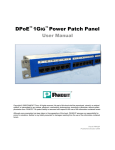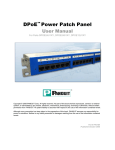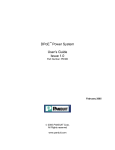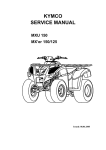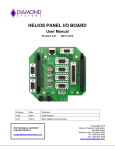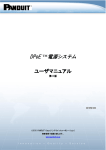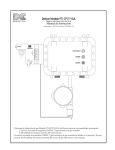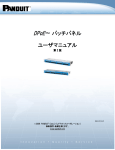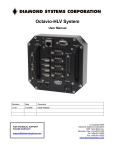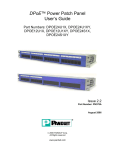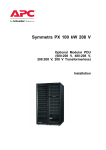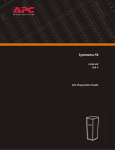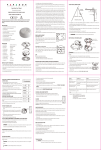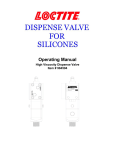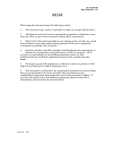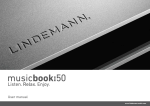Download Manual - eANIXTER
Transcript
DPoE™ Power System User Manual Copyright © 2012 PANDUIT Corp. All rights reserved. No part of this book shall be reproduced, stored in a retrieval system, or transmitted by any means, electronic, mechanical, photocopying, recording or otherwise, without written permission from PANDUIT. No patent liability is assumed with respect to the use of the information contained herein. Although every precaution has been taken in the preparation of this book, PANDUIT assumes no responsibility for errors or omissions. Neither is any liability assumed for damages resulting from the use of the information contained herein. Part # PN380D Published February 2012 DPOE™ Power System User Manual Part Number: PN380D SAFETY WARNING The DPOE™ Power Patch Panel Power System is for use in restricted access locations only. It is suitable for mounting on concrete or other non-combustible surfaces. Always observe standard safety precautions during installation, operation and maintenance of this product. Read the installation instructions before performing any work. Only a competent technician who is aware of the hazards involved should carry out adjustment, maintenance or repairs. Do not work on the system or connect or disconnect cables during periods of lightning activity. Ultimate disposal of this product should be handled according to all national laws and regulations. WARNING: HAZARDOUS VOLTAGE AND ENERGY LEVELS ARE PRESENT THAT CAN PRODUCE SERIOUS SHOCKS AND BURNS. Only authorized, qualified, and trained personnel should attempt to work on this equipment. CAUTION: The plug end of the cords used to connect to the Alternating Current (AC) source are considered to be the primary disconnect means, and reasonable access must be given to the plug and receptacle area. The receptacle must be fed with a breaker or fuse according to the instructions in this guide. CAUTION: ALL RECTIFIERS EMPLOY INTERNAL DOUBLE POLE/NEUTRAL FUSING. FCC Compliance Statement This device complies with Part 15 of FCC Rules. Operation is subject to the following two conditions: 1. This device may not cause harmful interference, and 2. This device must accept any interference received, including interference that may cause undesired operation. WARNING: Changes or modifications to this unit not expressly approved by the party responsible for the compliance could void the user's authority to operate this equipment. WARRANTY Unless otherwise specified, all products presented in this user's guide are warranted against defects in material and workmanship for a period of one year from the date of invoice by PANDUIT® Corp. to the initial purchaser. During the warranty period PANDUIT Corp. will, at its discretion, either repair or replace products that prove to be defective. For warranty service or repair, the product claimed to be defective must be returned to a service facility designated by PANDUIT Corp. Buyer shall prepay all the shipping charges to PANDUIT Corp. and if, in the opinion of PANDUIT Corp., the product is defective, PANDUIT Corp. shall pay shipping charges to return the product to Buyer. However, Buyer shall pay all shipping charges, duties and taxes for products returned to PANDUIT Corp. from another country. PANDUIT Corp. warrants that its firmware designed by PANDUIT Corp. for use with an instrument will execute its functions when properly installed on that instrument. PANDUIT Corp. does not warrant that the operation of the instrument or the firmware will be uninterrupted or error-free. The foregoing warranty shall not apply to defects resulting from improper or inadequate maintenance by Buyer (buyer-supplied firmware or interfacing unauthorized modification or misuse, operation outside of the environmental specifications for the product, or improper site preparation or maintenance). No other warranty is expressed or implied. PANDUIT Corp. specifically disclaims the implied warranties of merchantability and fitness for a particular purpose. ii DPOE™ Power System User Manual Part Number: PN380D The remedies provided herein are Buyer's sole and exclusive remedies. PANDUIT Corp. shall not be liable for any direct, indirect, special, incidental or consequential damages, whether based on contract, tort or other legal theory. Unless otherwise specified by PANDUIT Corp., opening this product by unauthorized personnel will void this warranty. TRADEMARKS DPOE™ and Contour Crimp are trademarks of PANDUIT Corporation. All other trademarks are the property of their respective owners. iii DPOE™ Power System User Manual Part Number: PN380D TABLE OF CONTENTS SAFETY WARNING ................................................................................................................... ii FCC Compliance Statement .................................................................................................... ii WARRANTY ............................................................................................................................... ii TRADEMARKS ......................................................................................................................... iii OVERVIEW ............................................................................................................................... 1 INSTALLATION......................................................................................................................... 2 Package Contents .................................................................................................................. 2 Heat Dissipation ..................................................................................................................... 3 AC Input Wiring ...................................................................................................................... 3 DC Output Wiring Sizing ........................................................................................................ 4 Connecting to a DPoE™ Power Patch Panel or Compact 8 Midspan .................. 5 Torque Settings ...................................................................................................................... 7 Required Tools ....................................................................................................................... 7 Site and Equipment Preparation............................................................................................. 7 POWER PLANT MOUNTING AND WIRING ............................................................................. 8 Mechanical Mounting ............................................................................................................. 8 Support Shelf Mounting (Optional) ......................................................................................... 8 AC Input ................................................................................................................................. 9 DC Output .............................................................................................................................. 9 TEST AND TURN-ON...............................................................................................................11 Rectifiers ...............................................................................................................................11 Power Up ..............................................................................................................................11 Short Circuit and Current Limit ..............................................................................................11 TROUBLESHOOTING..............................................................................................................12 Figures Figure 1 : Top View of Power Chassis with Power Rectifiers Installed ....................................... 1 Figure 2: Individual AC Feed Wiring Architecture ....................................................................... 4 Figure 3: DC Wire Diagram ........................................................................................................ 5 Figure 4: Connecting to a DPoE™ Power Patch Panel or Compact 8 Midspan .......................... 6 Figure 5: Chassis (Front View) ................................................................................................... 8 Figure 6: Optional Rack Mount Shelf .......................................................................................... 8 Figure 7: Cord Bracket ............................................................................................................... 9 Figure 8: Chassis (Rear View) - AC Connections ....................................................................... 9 Figure 9: Securing Cord Bracket to Chassis............................................................................... 9 Figure 10: Chassis (Front View) - GMT fuse holder ..................................................................10 Figure 11: GMT 7.5A DC Power Fuse .......................................................................................10 Figure 12: Chassis (Rear View) - DC Connections ....................................................................10 Figure 13: Installing or Removing Rectifiers ..............................................................................11 List of Tables Table 1: Package Contents ........................................................................................................ 2 Table 2: DPOE™ Power Components Available from PANDUIT ................................................ 3 Table 3: Heat Dissipation ........................................................................................................... 3 iv DPOE™ Power System User Manual Part Number: PN380D Table 4: Recommended AC Circuit Breaker and Wire Sizes ...................................................... 4 Table 5: Minimum Recommended DC AWG for 90°C Cabling for Unprotected Outputs............. 6 Table 6: Recommended Torque Settings ................................................................................... 7 Table 7: PANDUIT Corp. Contact Information ............................................................................ 7 Table 8: Troubleshooting ..........................................................................................................12 v DPOE™ Power System User Manual Part Number: PN380D OVERVIEW The DPOE™ Power Patch Panels and the DPOE™ Compact 8 Midspan provide a reliable and costeffective solution for Power over Ethernet (PoE) applications, complaint with the IEEE 802.3af-2003 specifications or the alternate PoE (Cisco Legacy) specifications. These DPOE™ Power over Ethernet Systems allow centralized powering of network devices, such as Voice over Internet Protocol-based (VoIP) telephones, IP security and surveillance cameras, or wireless access point (WAP) devices, over the same cabling used to send data. DPOE™ Power over Ethernet Systems fit into 19" racks and occupy 1RU height. The DPOE™ Power over Ethernet Systems may be powered individually using a DPOE™ Power Supply (PANDUIT part # DPOEPWRB120Y), which delivers 120 watts at 48 Volts of Direct Current (VDC) to a single DPOE™ Power Patch Panel or DPOE™ Compact 8 Midspan. However, 120 watts may not be enough power to support all the Powered Devices (PD) connected to the panel or powered midspan. In these cases, or in cases of multiple DPOE™ Power over Ethernet Systems, a larger power system is often required. One option is to use the DPOE™ Power System Chassis with Power Rectifiers, herein referred to as the DPOE™ Power System. The DPOE™ Power System uses a modular design to supply power at 48 VDC to DPOE™ Power over Ethernet Systems. The DPOE™ Power System consists of a chassis (PANDUIT part # DPOEPWRCU), which can accommodate up to three rectifiers (1250 watt rectifiers), depending on the current and future power requirements for the DPOE™ Power over Ethernet Systems being used. Figure 1 : Top View of Power Chassis with Power Rectifiers Installed The DPOE™ Power System accepts an Alternating Current Voltage (VAC) between 100 and 240 VAC (47 to 63 Hz) and produces a regulated output of 42 - 56 VDC capable of delivering a max of 10 Amperes (A) of Direct Current (DC) in an ambient operating temperature range of -40° Celsius (C) to +70° C per output channel. 1 DPOE™ Power System User Manual Part Number: PN380D INSTALLATION CAUTION: Observe all local and national electrical, environmental, and workplace codes. Each chassis should be fed from a dedicated AC branch circuit of a TN or IT power system. CAUTION: The plug ends on the power cords used for the AC connections are considered to be the primary disconnect means. Reasonable access must be given to the plug and receptacle area. The receptacle must be fed with a breaker or fuse according to Table 4: Recommended AC Circuit Breaker and Wire Sizes. Use single hole, Underwriters Laboratory (U.L.) listed lugs for the bulk DC connection to prevent lug rotation and inadvertent contact with other circuits. Terminal strip connections use compression screws. Class 1 wire is recommended for all DC connections. Minimum wire sizes for protected and unprotected circuits are shown in Table 5: Minimum Recommended DC AWG for 90°C Cabling for Unprotected Outputs , respectively. In practice, loop voltage drop considerations will usually dictate larger than minimum safe wire size. For connection and mounting torque requirements see Table 6: Recommended Torque Settings. PANDUIT Corp. does not recommend shipping the chassis with the rectifiers installed. Rectifiers should be shipped in their separate boxes. Package Contents The DPOE™ Power System chassis is shipped with the following included items. Table 1: Package Contents Item DPOE™ Power System User Manual QNTY. Notes 1 This manual Cord Brackets 3 Secures individual power cords to the rear of the DPOE™ Power System Chassis Screws with integrated washers 4 Secures DPOE™ Power System chassis to a 19” rack Nuts 2 Secures the lugs to the bulk DC connection on the rear of the DPOE™ Power System chassis Screws with integrated washers 6 #4-40 screws for securing the cord brackets to the back of the DPOE™ Power System chassis GMT Fuses 20 (4) 5 amp fuses and (16) 7.5 amp fuses 2 DPOE™ Power System User Manual Part Number: PN380D Table 2: DPOE™ Power Components Available from PANDUIT PANDUIT Part Number Description DPOEPWRB120Y Individual power supply - 120 watt power supply – 48 volt output DPOEPWRCU Unmanaged power chassis (supports 3 rectifiers) DPOEPWRR1250 1250 watt rectifier for use in power chassis DPOEPWRF7.5 7.5 amp fuse (package of 8) DPOEPWRF5 5 amp fuse (package of 4) CORD-A Power cord for Australia CORD-E Power cord for Europe CORD-S15 Power cord for North America CORD-J15 Power Cord for Japan CORD-U Power cord for the U.K. Heat Dissipation The following table displays the maximum and typical British Thermal Units per hour (BTU/hr) of heat dissipated from each rectifier. The maximum is calculated at 90 VAC, and typical is calculated at 230 VAC. Table 3: Heat Dissipation Part Number Typical BTU/hr Max BTU/hr DPoEPWRR1250 451 833 AC Input Wiring The DPOE™ Power System chassis uses an individual AC feed architecture (See Figure 2: Individual AC Feed Wiring Architecture), which requires one AC feed per rectifier. Up to three, AC connections are made using the IEC320 receptacles on the rear of the chassis (See Figure 8: Chassis (Rear View) - AC Connections). Connect each feed, using the appropriate power cord as listed in Table 2: DPoE™ Power Components Available into the appropriate receptacle on the back of the system. Cord securing brackets are included to secure the AC plugs to the chassis (See Figure 9: Securing Cord Bracket to Chassis). 3 DPOE™ Power System User Manual Part Number: PN380D N+1 DC Out Rectifiers 1 2 3 Feed 1 AC In Feed 2 Feed 3 Figure 2: Individual AC Feed Wiring Architecture Each individual AC feed should be protected using a circuit breaker as listed in Table 4: Recommended AC Circuit Breaker and Wire Sizes. Table 4: Recommended AC Circuit Breaker and Wire Sizes Type of Feed Number of Rectifiers on an AC Feed Individual AC Feed 1 Part Number Maximum Input Voltage Maximum Rated AC Current (A) Circuit Breaker Minimum value (A) 90° C Minimum Wire Gauge (AWG) to use at 30° C ambient DPOEPWRR1250 90 17.6 20 12 DPOEPWRR1250 180 8.8 15 14 DC Output Wiring Sizing There are two main considerations for sizing DC wire, ampacity and voltage drop. Ampacity refers to the safe current-carrying level as specified by U.S.-based organizations such as Underwriters Laboratories and the National Fire Prevention Association, which publishes the National Electric Code (NEC). Voltage drop is simply the amount of voltage loss in a length of wire due to ohmic resistance of the conductor. DC wire may be sized for either ampacity or voltage drop depending on branch load loop length and conductor heating. In general, ampacity considerations will drive wire selection for short loop lengths (less than 50 feet) and voltage drop will drive wire selection for long loop lengths (greater than 50 feet). The National Electric Code table 310.16 provides ampacity values for various sizes, bundles, and insulation temperature rated wire. 4 DPOE™ Power System User Manual CAUTION: Part Number: PN380D ALWAYS FOLLOW NEC GUIDELINES AND YOUR LOCAL COMPANY PRACTICES WHEN SELECTING DC WIRING AND PROTECTION. Table 5: Minimum Recommended DC AWG for 90°C Cabling for Unprotected Outputs shows recommended wire sizes based on ampacity. The maximum current rating for the chassis is 100 A. Rectifiers 1 2 14 Single hole bulk battery connections (¼" studs) 14 GMT Fuse Connections Figure 3: DC Wire Diagram Each chassis is equipped with 14 GMT style fuse connections and an unfused bulk DC connection located on the rear of the chassis. The GMT fused connections are made on “lugless” terminal blocks with compression screws. The terminal blocks will accept wire sizes up to 12AWG. The bulk DC connection may be used as a battery input or as an unfused bulk output. The connections require a terminal lug (1/4” single hole lug with a max tongue width of 0.63” or less), such as PANDUIT part # LCA4-14-L. Size wires based on the total rectifier capacity and choose conductor size according to Table 5: Minimum Recommended DC AWG for 90°C Cabling for Unprotected Outputs . Connecting to a DPoE™ Power Patch Panel or Compact 8 Midspan Each DPOE™ Power over Ethernet System is shipped with a keyed power connector harness and two butt splices (PANDUIT part # BSV14X) for use in connecting the panel to the power source. The butt splices included with the DPOE™ Power Patch Panel will support 14 - 16 AWG solid or stranded wire. WARNING: Connect each separate DPOE™ Power Patch Panel or Compact 8 Midspan to the rear of the DPOE™ Power System using one of the 14 GMT-fused outputs per panel. Do not wire multiple untis to a single output on the DPOE™ Power System. 5 DPOE™ Power System User Manual Part Number: PN380D Figure 4: Connecting to a DPoE™ Power Patch Panel or Compact 8 Midspan NOTE: The included power harness has two wires for the A-feed power only (pins 1 & 2). The DPOE™ Power Patch Panel or Compact 8 Midspan supports an optional redundant B-feed power option, but the terminals and wire leads are not attached to the power harness. Contact PANDUIT Technical Support for more information about connecting the redundant B-Feed power. (PANDUIT part # DPOEPWRDUAL should be used for redundant powering options) WARNING: The power supply connections on the DPOE™ Power Patch Panel and the Compact 8 Midspan are polarized. They will not function if power is wired improperly. Table 5: Minimum Recommended DC AWG for 90°C Cabling for Unprotected Outputs 1 Total Rectifier Current Rating (A) Wire and Lug Gauge (AWG) using 90° C wire 10 20 25 (NEC Table 310.16) 16 14 12 1 Table 310.16 uses Table 3B – Sizes of Conductors from BS EN 60950:2000, “Safety of Information Technology Equipment,” December 2000 for non-building wiring. 6 DPOE™ Power System User Manual Part Number: PN380D Torque Settings The following table shows recommended torque settings for all mechanical and electrical connections according to screw or nut size in inch pounds (in-lbs). Table 6: Recommended Torque Settings Screw or Nut Size Toque (in-lbs) 4-40 6-32 8-32 10-32 12-24 ¼-20 6 12 22 37 50 65 Required Tools The DPOE™ Power System is designed to be installed with commonly available tools: • • • • • • #1 & #2 flat blade and Phillips head screwdrivers Torque wrench 7/16” socket, ¼” drive Wire and cable strippers (PANDUIT part number CT-100) Wire and cable crimpers (such as PANDUIT part CT-1550, CT-1551, CT-1570, CT-1700 TM Contour Crimp Controlled Cycle Crimp Tools) (used for optional bulk DC connection) Site and Equipment Preparation Prior to unpacking the DPOE™ Power System, note any physical package damage that could indicate potential damage to the contents. After removing the DPOE™ Power System from the boxes and packing material, inspect for shipping and/or other damage. Any problems should be reported to PANDUIT technical support. Table 7: PANDUIT Corp. Contact Information PANDUIT Technical Support Fax: 1-708-444-6993 E-mail: [email protected] PANDUIT Product Installation Instructions www.panduit.com/resources/install_maintain.asp Worldwide Subsidiaries and Sales Offices www.panduit.com Have all tools, wire, cables, hardware, etc., within easy reach. To the extent possible, ensure a clean (free of debris, dust, foreign material, etc.) work environment. Care should be taken in the installation process to prevent wire clippings from getting into the equipment. NOTE: If possible, the rectifiers should remained sealed in their shipping boxes until the chassis wiring is complete. Rectifiers should not be inserted until all DPOE™ components are properly connected. 7 DPOE™ Power System User Manual Part Number: PN380D POWER PLANT MOUNTING AND WIRING WARNING: Ensure all AC and DC power sources are off and disconnected. WARNING: Power to the DPoE power system chassis should be disconnected prior to performing any power line maintenance to prevent damage to the rectifier. Mechanical Mounting The DPOE™ Power System chassis is installed in a standard EIA 19” rack. It is recommended that one person lift the chassis into the proper rack place while another person installs the supplied mounting screws. Tighten the screws with a torque wrench to the setting according to Table 6: Recommended Torque Settings. Mounting Brackets Slots for Rectifiers In shelf distribution Figure 5: Chassis (Front View) Support Shelf Mounting (Optional) After securing the DPOE™ Power System chassis with mounting screws in the front, an optional rack mount shelf may be installed underneath the chassis on the backside of the rack to alleviate potential sagging of the chassis unit, due to weight distribution when mounted on a 2-post rack. PANDUIT offers a 1RU shelf (part # SRM19FM1) with a load rating of 30 lbs that will help support the chassis. For optimum saftety, a 2 RU shelf (PANDUIT part # SRM19FM2 – shown below) with a load rating of up to 50 lbs may be installed. Attach power chassis to front of rack using Mounting Brackets Optional Rack Mount Shelf (attached to back of rack with shelf turned upside down) Figure 6: Optional Rack Mount Shelf 8 DPOE™ Power System User Manual NOTE: Part Number: PN380D Optional rack shelf is actually installed upside down to the rear of the rack to allow power chassis to rest on the flat side of the shelf. AC Input Slip the cord bracket around each cord (PANDUIT part # CORD-****), as shown in Figure 7: Cord Bracket. Plug the cord into the proper receptacle on the back of the chassis (See Figure 8: Chassis (Rear View) - AC Connections), then secure the cord bracket to the chassis using the provided screws (See Figure 9: Securing Cord Bracket to Chassis). Figure 7: Cord Bracket Figure 8: Chassis (Rear View) - AC Connections Figure 9: Securing Cord Bracket to Chassis DC Output DC connections are accomplished via the rear terminal blocks and bulk output connection as shown in Figure 12: Chassis (Rear View) - DC Connections. GMT-fused connections are accomplished via the rear compression screw terminal block that will accept wires sizes up to 12 AWG. If a fuse is not in 9 DPOE™ Power System User Manual Part Number: PN380D corresponding slot, then place wire in output and corresponding return, and compress the screws to 4 inlbs. Place a fuse into the corresponding position into the fuse holder as shown in Figure 10: Chassis (Front View) - GMT fuse holder. The DPOE™ Power System Chassis allows a bulk DC connection as shown in Figure 12: Chassis (Rear View) - DC Connections. The bulk DC connection may be optionally used to ensure continued power to the connected DPOE™ Power Patch Panels and the PD connected to the panels in the event of a power failure. This connection may be used as a battery input or as an unfused bulk output. The bulk DC connection requires properly crimped terminal lugs (1/4” single hole lug with a max tongue width of 0.63” or less). Terminal lugs (such as PANDUIT part # LCA4-14-L for use with #3 or #4 AWG stranded wire or #2 AWG solid wire) and crimping tools (such as the PANDUIT part #s CT-1550, CT-1551, CT-1570, or CT-1700) are available from PANDUIT Corp. The bulk output terminals feature a break-off plastic piece to prevent inadvertent contact with the terminals. If using the bulk DC output feature, carefully break off each plastic tab before securing the terminal lugs. Size wires based on the total rectifier capacity and choose conductor size according to Table 5: Minimum Recommended DC AWG for 90°C Cabling for Unprotected Outputs . For battery or bulk DC connections, place lug on the corresponding positive and negative studs, and secure the connections with the included nuts. Figure 10: Chassis (Front View) - GMT fuse holder Figure 11: GMT 7.5A DC Power Fuse GMT fused return output connections (White wire on Power Patch Panel Connector Kit) Positive Output or Battery Input Negative Output or Battery Input GMT fused negative output connections (Black wire on Power Patch Panel Connector Kit) Figure 12: Chassis (Rear View) - DC Connections 10 DPOE™ Power System User Manual Part Number: PN380D TEST AND TURN-ON Once all AC and DC connections have been secured and checked, install each rectifier sequentially by sliding and latching it into the chassis as illustrated in the section below. Rectifiers The rectifiers for use in the DPOE™ Power System are equipped with Light Emitting Diodes (LEDs) on the front panel as a means to indicate problems with that specific rectifier. The rectifiers are designed as modular, field replaceable units. Power Up Plus all AC power cords into an appropriate Power Supply Unit (PSU), or Uninterruptible Power Supply (UPS). In the event that a rectifier needs to be removed, press the latch button on the front of the rectifier to release the latch handle. Pull the latch handle until the rectifier clears the rear connector on the chassis, then gently slide it out of the rear connector. With the latch handle open on the replacement rectifier, slide the rectifier in until it connects with the backplane. While pressing the latch button down, use the latch handle to gently ease the rectifier into the rear connector. When the rectifier is properly seated, releasing the latch button will hold the latch handle in place. WARNING: The latch handle must be open for installation or removal of a rectifier. Attempting to install a rectifier with the latch handle closed will result in mechanical damage to the rectifier and the DPOE™ Power System chassis. The rectifier will power up and configure itself. It will start in high fan speed mode and reduce the speed according to the ambient and plant conditions within 10 seconds. Figure 13: Installing or Removing Rectifiers Short Circuit and Current Limit ILimit can be adjusted up to +105% of the rated current of the rectifier. The system voltage will remain constant up to ILimit at which point the system voltage will drop quickly toward 0 VDC. Once a 48V rectifier output drops below 12 VDC for more than 5 seconds, the system will shut down. The system will automatically restart after 60 seconds, and will continue until the short circuit is cleared. 11 DPOE™ Power System User Manual Part Number: PN380D TROUBLESHOOTING The modular nature of this DPOE™ Power System makes diagnostics and repair easy. Make sure that all rectifiers are properly seated and latched into their respective slots. Make sure all power and signal connectors are properly mated. Table 8: Troubleshooting Alarm Problem Possible Solution DC OK LED is extinguished This rectifier has stopped outputting power Rectifier failed. Replace this unit. AC OK and all LEDs are extinguished Commercial power has been lost to the specified rectifier(s) Reset commercial circuit breaker to the dedicated AC circuit that feeds the system. Seek alternative power source until power is restored. Fuse Open A fuse is in the open state Replace the open fuse 12


















